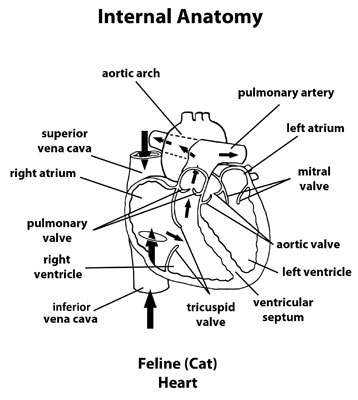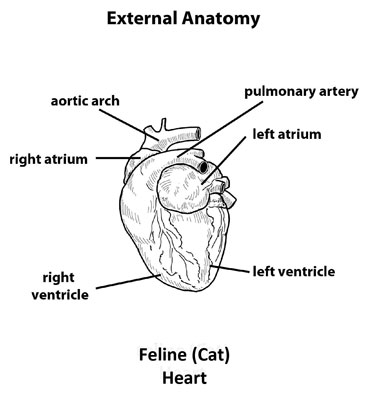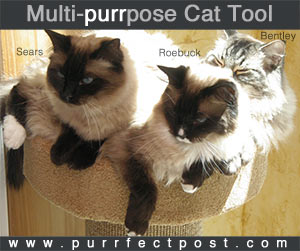Heart Disease in Cats
 Heart disease, or cardiac disease, can be a devastating clinical condition in companion animals. Early recognition and treatment can facilitate appropriate clinical management and a long life.
Heart disease, or cardiac disease, can be a devastating clinical condition in companion animals. Early recognition and treatment can facilitate appropriate clinical management and a long life.
How Does the Heart Work?
The feline heart is a hard-working organ and is divided anatomically into four chambers; the left and right ventricles and left and right atria. Valves between the sections allow for blood flow throughout the heart. The external heart “sac” is called the pericardium, and the myocardium is the actual muscle of the heart. The endocardium is the inner layer of cells in the heart. Heart disease, or cardiac disease, can affect any of these components.“Dirty” blood (carrying carbon dioxide from organs, tissues, and cells) enters the right atrium through large vena cava veins and flows to the right ventricle via the tricuspid valve. It then travels through the pulmonary artery (via the pulmonary valve) to the lungs to collect oxygen and eliminate carbon dioxide and re-enters the left atrium through the pulmonary vein. The mitral valve ferries the oxygen-rich blood to the left ventricle, and the aorta (entering through the aortic valve) carries “clean” oxygen-rich blood to the remainder of the body.
Common Types of Heart Disease in Cats
Cardiac disease is classified as either congenital or acquired.
Most congenital cardiac defects are present from birth or near birth and include conditions such as septal defects (atrial and ventricular), valve dysplasias, and congenital cardiomyopathies. All involve some degree of structural heart or valvular dysfunction. Although some breed-associated congenital conditions are detected early in life, others are not identified until adulthood; Maine Coon cats are frequently diagnosed with cardiac disease.
Acquired conditions can also affect any heart component and are not present at or near birth. They develop over time and with age, and many are not pathologic or progressive. However, some may be associated with progressive heart and valve disease.
- The most common acquired feline heart disease is hypertrophic cardiomyopathy; this is a thickening of the heart muscle which causes heart failure.
- Endocarditis, myocarditis, and pericarditis are structural inflammatory conditions that result from a variety of causes, including infectious, traumatic, and immune conditions.
- Pericardial effusion occurs when excessive fluid collects between the layers of the pericardial sac; its causes are diverse and can include cancer.
- Valvular endocardiosis, valvular degeneration, and valvular regurgitation/insufficiency are frequently identified valvular conditions in cats.
- Hyperthyroidism can also negatively affect the feline heart.
What Is a Heart Murmur?
A heart murmur is an extra sound in the heart beat, which is detected by the veterinarian during the physical examination. Such murmurs usually develop secondary to turbulent blood flow. Heart murmurs are identified in patients with and without heart disease.
Many murmurs are innocent, particularly those identified in young kittens without any evidence of cardiac disease. They are soft murmurs and usually disappear on their own. Other benign murmurs are seen secondary to anemia (decreased red blood cell count), pain, and intense excitement.
Pathologic murmurs may have very characteristic sounds and locations and are associated with cardiac disease.
Signs of Feline Heart Disease
Clinical signs and complications of heart disease in cats can include:

- Pale or lilac-colored mucous membranes
- Weak pulses
- Cold extremities
- Poor circulation
- Fainting
- Jugular vein pulses
- Breathing difficulties
- Coughing
- Exercise intolerance
- Heart murmurs
- Clots in the arteries
- Fluid collection in the abdomen
- Edema or swelling of the limbs
- Weight loss (cardiac cachexia)
Note: Breathing difficulties are an extremely common cardiac complication in cats because of fluid retention inside or outside the lungs.
Feline aortic thromboembolic disease (FATE) results from clot formation in the diseased heart, particularly in cats with hypertrophic cardiomyopathy. The clots travel through the aorta as it descends and may partially or completely obstruct aortic flow. This cuts off rear leg blood supply and causes rear leg paralysis; it can be very painful. Such cats will present to the clinic with weak or absent pulses and paralyzed legs that are ice-cold to the touch. It is a devastating consequence of feline cardiac disease.
Diagnosis of Heart Disease in Cats
Diagnosis is usually facilitated by a combination of cardiac ultrasonography (ultrasound), chest x-rays, blood pressure measurement, blood work/cardiac enzyme level measurement, urinalysis, and electrocardiogram analysis. Veterinary cardiologists may perform more advanced diagnostics in necessary cases.
Treatment of Heart Disease in Cats
Treatment is dependent on the causative factor of the heart disease; its goal is to slow the progression of heart failure. Treatment may include any of the following therapies and drugs:
- Antibiotics: Antibiotics are used to treat infectious causes of cardiac disease.
- Angiotensin converting enzyme (ACE) inhibitors: This class of drugs can increase the blood output of the heart, increase sodium loss in the urine, and decrease blood pressure.
- Diuretics: These promote urine formation to assist in fluid removal from the body.
- Dietary modification/low salt diets: These can help decrease the heart's workload.
- Positive inotropes: These drugs increase the ability of the heart muscle to contract.
- Taurine therapy: Taurine is an amino acid that is critical for feline heart health.
- Vasodilators: These can assist in lowering blood pressure and treating congestive heart failure.
- Calcium-channel blockers: These drugs can assist in high blood pressure and congestive heart failure.
- Anti-clotting agents: These help prevent the formation of dangerous clots.
- Fluid removal from the pleural space or abdomen: This is a manual technique performed by a veterinarian to remove extra fluid from the chest or abdomen of a cat in heart failure.
- Surgery: Surgery may be required in certain cases, particularly in congenital cardiac disease.
Prognosis of Heart Disease in Cats
Prognosis is completely dependent on the etiology, or cause, of the heart disease and how advanced it is.
You May Also Like These Articles:
Flame Retardants and Hyperthyroidism in Cats
Saddle Thrombus: Aortic Blood Clots in Cats
Notice: Ask-a-Vet is an affiliated service for those who wish to speak with a veterinary professional about their pet's specific condition. Initially, a bot will ask questions to determine the general nature of your concern. Then, you will be transferred to a human. There is a charge for the service if you choose to connect to a veterinarian. Ask-a-Vet is not manned by the staff or owners of CatHealth.com, and the advice given should not delay or replace a visit to your veterinarian.





